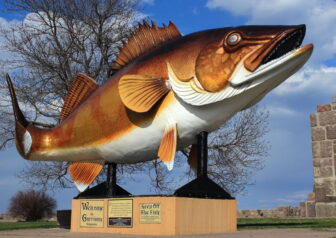
Garrison, Minnesota, is home to a large walleye statue sitting down on the shore of Mille Lacs, a well-liked walleye fishing lake. Image: City of Garrison.
By Abigail Comar
Walleye. A major predator fish with a cult-like following in the Excellent Lakes.
Paul Radomski’s new guide Walleye: A Beautiful Fish of the Darkish (College of Minnesota Push, $24.95) particulars the biology, administration and worth of this legendary fish.
Radomski, a fisheries biologist by trade, mentioned he hopes readers will consider absent a larger appreciation for walleye as they learn extra about it.

Walleye: A Beautiful Fish of the Darkish cover. Impression: University of Minnesota Press.
“How do they live, what is their habitat, why do they prosper, what are their troubles to survive?” Radomski mentioned. “I know a great deal of folks fish for walleye, but sometimes it’s very good to be curious about these information.”
Radomski said his inspiration for the e-book goes back again to his childhood. He grew up fishing the Wisconsin River in the vicinity of Stevens Issue, Wisconsin, and said which is the place he fell in enjoy with walleye.
“The much more you’re exposed to one thing, the more you occur to respect or adore it,” Radomski explained. “I fell into terrific fascination with walleye, even to just understand the basic points about them.”
He resolved to study fisheries so he could get paid to examine the fish he loves.
Radomski has been functioning as a fisheries biologist for more than 30 years and stated it appeared like crafting a book was a fantastic way to relate some of his experiences to points about walleye.
Spanning around 200 web pages, the e book is break up into 3 sections. The sections discover the biology and administration of the fish and contain circumstance scientific studies about folks coming alongside one another to check out to preserve the species.
Radomski claimed he at first never ever prepared to compose a e book about walleye. Immediately after finishing a e-book on lake ecology and progress with a colleague, an editor at the College of Minnesota Press questioned to meet up with with him.
“He mentioned, ‘We have a genuinely fantastic reserve on northern pike, but we don’t have a walleye e book,’” according to Radomski. “I said, ‘You really don’t, and you should really.’ Then he asked me to publish it.”
Radomski said he wrote it pretty rapidly since it is a fish he enjoys conversing about.
“When people today request you to do a little something, in some cases it pays just to say yes,” Radomski. “I almost certainly would’ve regretted it if I did not choose him up on the offer.”
He said the title was originally just a placeholder, but it trapped with the publisher.
“The biology of walleye is seriously interesting from the adaptation of its eye,” Radomski mentioned. “It’s adapted to see in low light-weight situations and that’s the place it is most active. I noticed the magnificence in a straightforward attribute of this fish.”
To any person who has observed a walleye, the eyes unquestionably stick out, and they are the important to describing a lot of of its behaviors, according to Radomski.
In the Wonderful Lakes, it’s difficult to have not witnessed a walleye. No matter if it is by fishing, driving past a statue or examining a menu, the fish is an integral part of the area’s culture.
An investigation by the Washington Article statements that walleye is the most Midwestern detail on Earth.
Radomski described examining that short article while outlining the craze men and women expertise from them.
Even so, he mentioned he was amazed by the audience for his guide. He experienced imagined that readers would mostly be anglers who by now appreciate the fish, but observed the audience is considerably wider following attending a current e-book party.
“The audience was dominated by girls who weren’t anglers but have been genuinely interested in mother nature or understanding the walleye they consume in the restaurant,” Radomski reported.
Regardless of the audience demographics, Radomski explained he hopes visitors have an understanding of why and how to do the job collectively to make sure an enduring long run for walleye.
“I want people to realize that numerous of our actions have repercussions on the things we enjoy, like fishing for walleye,” Radomski stated. “It’s taking place now.”
He explained that fisheries biologists are currently viewing walleye change their vary northward as water temperatures heat. He also talked about forests remaining turned to farmland as negatively impacting water quality, and that is hurting walleye.
But there is a route ahead, centered on doing work jointly to guard walleye habitat, Radomski explained.
“We can enjoy walleye fishing, but we should give back again some thing to walleye,” he explained.
